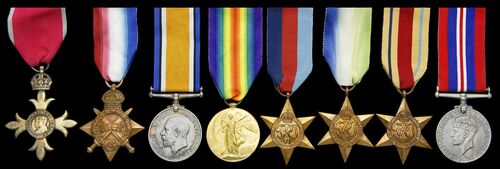
Auction: 24001 - Orders, Decorations and Medals
Lot: 120
A 1946 O.B.E. group of eight awarded to Engineer T. Bellis, Merchant Navy, late Marine Fleet Auxiliary
The Most Excellent Order of the British Empire, Civil Division, 2nd Type, Officer's (O.B.E.) breast Badge, silver-gilt; 1914-15 Star (Engr. T. E. Bellis. M.F.A.); British War and Victory Medals (Engr. T. E. Bellis. M.F.A.); 1939-45 Star; Atlantic Star; Africa Star; War Medal 1939-45, generally very fine or better (8)
O.B.E. London Gazette 9 January 1946. (Chief Engineer Officer, S.S. Sandak, Moss Hutchison Line).
Thomas Bellis was born on 29 August 1889 at Liverpool, Lancashire. He commenced an apprenticeship as a fitter at the Albert Engine Works in Liverpool on 29 July 1905. He completed his training but was obliged to make up ten days time lost before receiving his indenture on 7 August 1910. He remained with the Albert Engine Works for a further 5 months and 21 days, working as a fitter, leaving on 28 January 1911. Having decided to take up a seagoing career, he joined SS Konakry as 4th Engineer, eventually signing on for a foreign voyage leaving on 23 February 1911. Apart from a fortnight off Articles, he served in this ship for the next eighteen months, being promoted to 3rd Engineer in December 1911, finally leaving her in mid-October 1912.
Having completed the requisite sea time, he went up to one of the Liverpool marine engineering schools and took the examination for the Board of Trade Second Class Engineer's Certificate of Competency (Steam) and passed, on 26 November 1912. The certificate itself, No 53447, was issued on 2 December 1912. He then returned to his company (Pacific Line) and stood by for about three weeks as a "Staff Fitter" and then joined SS Menepthah as 3rd Engineer, being promoted to 2nd Engineer after two months and signing off in May 1913. His next ship was SS Busiris as 2nd Engineer for two voyages totalling just over three months. Leaving in late October 1913, a week later he joined SS Vosges as 2nd Engineer for five short voyages, averaging ten days each, finally leaving this ship on 5 January 1914. On 14 January he was appointed to SS Sebek as 3rd Engineer for three voyages, each about two and a half months duration, finally signing off on 22 September 1914, and he again returned to school. The Board of Trade was satisfied with his sea time and on 23 November 1914 he applied for examination as a First Class Engineer (Steam). He passed and the certificate was issued on 1 December 1914.
His wartime service is unknown, neither is anything up until 1928 when he applied for examination for a Motor Endorsement to his First Class Certificate.
In 1940 he was serving aboard SS Delius, a 6055 ton passenger cargo liner owned by Lamport and Holt, Built in 1936. During the Norwegian campaign of 1940, the ship was in Romdalsfjord and was attacked almost continuously during the 27 and 28 April by Junkers Ju.87 dive bombers. Her master, a Captain W. W. Watson was awarded the O.B.E.. After this, nothing remarkable happened until November 1943, when on 13 November, German agents reported the sailing of Convoy MKS 30 from Gibraltar. The next day the convoy merged with Convoy SL139, making up a 66 ship convoy escorted by the 40th Escort Group under Cdr Legassick R... During the next two days the convoy's progress was tracked by Luftwaffe maritime reconnaissance aircraftand the U-boat Wolfpack "Schill 1", comprising U211, U228, U262, U515 and U600 moved during the night of 18/19 November to a position off Lisbon ready to attack. A strong attack was by now expected and the Escort Group was reinforced.
Quite independently, U333 attempted to attack on 18 November but was depth charged ad damaged but the sloop Chanticleer was damaged beyiond repair by a torpedo from either U515 or U238 (she survived and served as a base ship, renamed Lusitania, in the Azores from December 1943. A Wellington bomber from 179 Sqn RAF caught U211 on the surface and sank her. On 20 October the Luftwaffe used FW200 Condor long range bombers against the convoy and another U-boat Wolfpack "Schill 2" (comprising U86, U238, U343, U536, U586, U608, U648, U709 and U969) formed up across the path of the convoy. That night U618 joined up with the others and made a surface rendezvous with U648. They were caught on the surface by a Short Sunderland of 422 Sqn R.C.A.F. and a Liberator from 53 Sqn R.A.F. but the combined flak barrage from the two submarines shot down both aircraft.
The following day the Germans deployed 25 Heinkel 177s aircraft loaded with Henschel Hs293 radio controlled glider bombs to attack the convoy. Several hit and crippled SS Marsa and SS Delius, hitting the latter immediately in front of the ship. The Master, Captain J H George, and three others were killed and the ship badly damaged. Seven aircraft were shot down and another four crashed due to engine fires.
Bellis, by then Chief Engineer of SS Samdak was awarded the O.B.E. (Civil) in the New Year Honours of 1946. Samdak was a cargo tramp, one of a large class of wartime built "Sam" boats, operated by the Moss-Hutchison Line for the Ministry of Transport. Built in 1943, she was 7219 tons and survived the war.
Subject to 20% VAT on Buyer’s Premium. For more information please view Terms and Conditions for Buyers.
Sold for
£240
Starting price
£220




